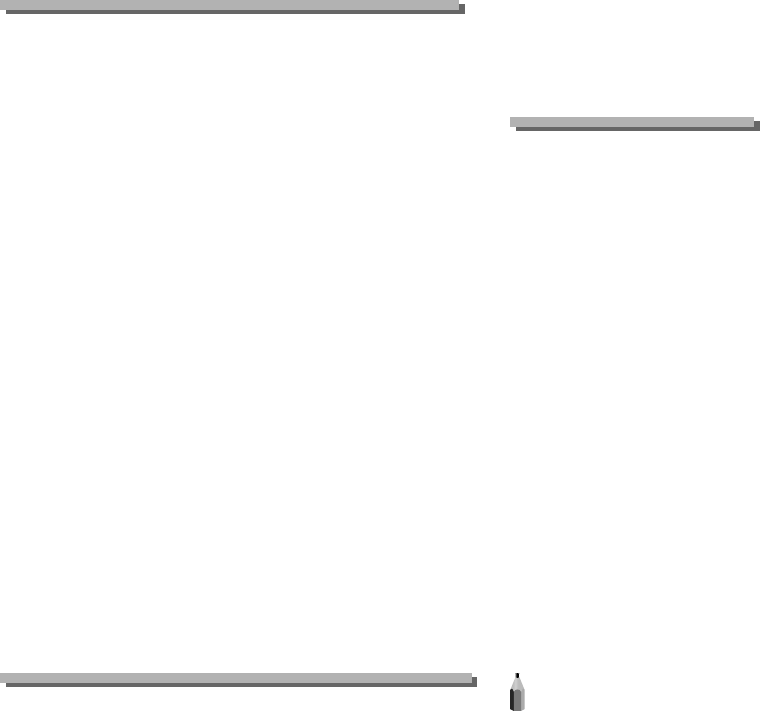
xiv
Using your product to scan, print or otherwise reproduce
certain documents, and the use of such images as scanned,
printed or otherwise reproduced by your product, may be pro-
hibited by law and may result in criminal and/or civil liability.
A non-exhaustive list of these documents is set forth below.
This list is intended to be a guide only. If you are uncertain
about the legality of using your product to scan, print or oth-
erwise reproduce any particular document, and/or of the use
of the images scanned, printed or otherwise reproduced, you
should consult in advance with your legal advisor for guidance.
Paper Money
Money Orders
Certi cates of Deposit
Postage Stamps (canceled or uncanceled)
Identifying Badges or Insignias
Selective Service or Draft Papers
Checks or Drafts Issued by Governmental Agencies
Motor Vehicle Licenses and Certi cates of Title
Travelers Checks
Food Stamps
Passports
Immigration Papers
Internal Revenue Stamps (canceled or uncanceled)
Bonds or Other Certi cates of Indebtedness
Stock Certi cates
Copyrighted Works/Works of Art without Permission of
Copyright Owner
Color imageCLASS MF8350Cdn: F157902
Color imageCLASS MF8050Cn: F157802
This device complies with Part 15 of the FCC Rules. Operation
is subject to the following two conditions:
(1) This device may not cause harmful interference,
and
(2) this device must accept any interference received, including
interference that may cause undesired operation.
This equipment has been tested and found to comply with the
limits for a class B digital device, pursuant to Part 15 of the FCC
Rules. These limits are designed to provide reasonable protec-
tion against harmful interference in a residential installation.
This equipment generates, uses and can radiate radio frequen-
cy energy and, if not installed and used in accordance with the
instructions, may cause harmful interference to radio com-
munications. However, there is no guarantee that interference
will not occur in a particular installation. If this equipment does
cause harmful interference to radio or television reception,
which can be determined by turning the equipment o and
on, the user is encouraged to try to correct the interference by
one or more of the following measures:
Reorient or relocate the receiving antenna.
Increase the separation between the equipment and re-
ceiver.
Connect the equipment to an outlet on a circuit di erent
from that to which the receiver is connected.
Consult the dealer or an experienced radio/TV technician for
help.
Use of shielded cable is required to comply with class B limits
in Subpart B of Part 15 of the FCC Rules. Do not make any
changes or modi cations to the equipment unless otherwise
speci ed in this manual. If you make such changes or modi ca-
tions, you could be required to stop operation of the equip-
ment.
•
•
•
•
•
•
•
•
•
•
•
•
•
•
•
•
•
•
•
•
Canon U.S.A., Inc.
One Canon Plaza, Lake Success, NY 11042, U.S.A.
TEL No. 1-800-OK-CANON
Pre-Installation Requirements for Canon Facsimile Equipment
A. Location
Supply a suitable table, cabinet, or desk for the machine.
See Chapter 11, “Appendix,” for speci c dimensions and
weight.
B. Order Information
1. A single telephone line (touch-tone or rotary) should be
used.
2. Order an RJ11-C telephone wall jack (USOC), which
should be installed by the telephone company. If the
RJ11-C wall jack is not present, telephone/facsimile op-
eration is not possible.
3. Order a normal business line from your telephone
company’s business representative. The line should be
a regular voice grade line or an equivalent one. Use one
line per unit.
DDD (Direct Distance Dial) line
-or-
IDDD (International Direct Distance Dial) line if you com-
municate overseas
NOTE
Canon recommends an individual line following industry
standards, i.e., 2,500 (touch-tone) or 500 (rotary/pulse dial)
telephones. A dedicated extension o a PBX (Private Branch
eXchange) unit without “Call Waiting” can be used with your
facsimile unit. Key telephone systems are not recommended
because they send nonstandard signals to individual tel-
ephones for ringing and special codes, which may cause a
facsimile error.
C. Power Requirements
The machine should be connected to a standard 120 volt
AC, three-wire grounded outlet only.
Do not connect this machine to an outlet or power line
shared with other appliances that cause "electrical noise.”
Air conditioners, electric typewriters, copiers, and machines
of this sort generate electrical noise that often interferes
with communications equipment and the sending and
receiving of documents.
Connection of the Equipment
This equipment complies with Part 68 of the FCC rules and
the requirements adopted by the ACTA. On the rear panel of
this equipment is a label that contains, among other informa-
tion, a product identi er in the format of US:AAAEQ##TXXXX.
If requested, this number must be provided to the telephone
company.
The REN (Ringer Equivalence Number) is used to determine the
number of devices that may be connected to a telephone line.
Excessive RENs on a telephone line may result in the devices
not ringing in response to an incoming call. In most, but not
all areas, the sum of the RENs should not exceed ve (5.0). To
be certain of the number of devices that may be connected
to a line, as determined by the total RENs, contact the local


















